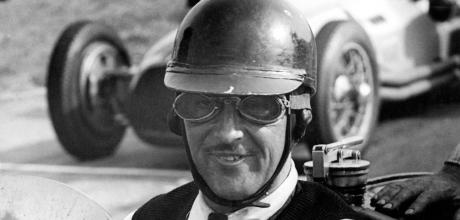Aston Martin drivers - St John ‘Jock’ Horsfall
St John ‘Jock’ Horsfall was responsible for one of Aston Martin’s most important post-war victories yet he’s arguably best known for his work for the.
Due to its secrecy, St John Horsfall never received any recognition for the speed in which he covered the 420-mile journey from London to a Scottish naval base, but because of what he was carrying in his van, it was one of his most important races. With Horsfall working for MI5, the journey would play a minor but important role in the Allies’ victory in the second world war.
Born on 31 July 1910 in Morningthorpe, a few miles outside Norwich, Horsfall (known as ‘Jock’ by his family and friends) initially enjoyed a successful career as a stockbroker. But despite suffering from poor eyesight, motor racing was always his true passion and in 1933 he bought an old Aston Martin. Although he had no training in engineering, he prepared the car himself and in June 1934 won a special award in class at Brooklands.
In 1937 Horsfall bought a year-old Aston Martin 2-Litre Speed Model that was fitted with an Ulster-style of body that would later be known as the ‘Black Car’. To tow the car to races, he used a Fordson van with an engine he’d rebuilt with performance parts that could apparently reach 100mph.
In July 1937 he won the Leinster Trophy Race held on the Tallaght Road course located on the outskirts of Dublin before taking a fi ne second place (and first in class) in the 1938 RAC Tourist Trophy at Donington behind the more powerful 3.0-litre Delage D6-70 of Louis Gérard. For the following season he often shared the Prince B. Bira’s former ERA – the famous Remus – with its new owner, the future Le Mans winner, Tony Rolt.
When racing came to a halt due to the outbreak of war in September of the same year, because of his driving skills, he was recruited by British intelligence, MI5, to transport secret agents.
In 1943 he was involved in Operation Mincemeat, an espionage plan to divert attention from the Allies’ planned invasion of Sicily in July the same year. A homeless man who had been found dead in London – later named as Glyndwr Michael from Wales – was made to look like a British officer whose plane had crashed off Spain’s southern Atlantic coast. The misinformation he was carrying in a briefcase, chained to his hand, was designed to convince the Germans that the Allies would invade the Balkans and Sardinia instead.
During the early hours of the 17 April, Horsfall transported the body to Greenock Dock in west Scotland where it would be transported by a British submarine, HMS Seraph. Behind the wheel of his fast Fordson van, he drove through the night, his headlights heavily obscured by their wartime blackout covers. With the two MI5 agents responsible for the ruse, Charles Cholmondeley and Ewen Montagu, in the rear, Horsfall came close to crashing several times. Thankfully, he reached his secret destination in one piece and the body together with the two British spies were loaded on to the sub.
After the body was found floating in the sea by local fishermen near Huelva almost two weeks later, the information it carried was sent to Berlin. With the Germans believing the misdirection, there was less resistance to the Allies’ Sicily invasion than expected.
When hostilities ended, Horsfall quickly returned to racing. In 1946 he travelled to the continent and won the 2,000cc support race of the Belgium Grand Prix with the Black Car at the Bois de la Cambre track in Brussels.
Two years later and together with Leslie Johnson, Horsfall returned to Belgium to drive the prototype of a new Aston Martin model, later known as the 2-Litre Sports, at the arduous Spa 24-hour race in July. Although the car was largely untested, the pair won comfortably.
“This convincing victory by this new British high-performance car puts Aston Martin right on the map again in a sphere of competition activity in which this make has always excelled,” was Motorsport magazine’s view in its August 1948 issue. At the same race the following year, despite arranging to share the Black Car with the Belgian driver Paul Frère, Horsfall decided to drive alone. Amazingly, he still finished the 24-hour race in a credible fourth overall plus second in the 2.0-litre class. But this would be Horsfall’s final major success. While driving an ERA R11B at the first edition of the International Daily Express Trophy Race at Silverstone in August the same year, he lost control at Stowe corner. After hitting a straw bale, Horsfall was thrown out when the car rolled and killed instantly when it landed on him.
Although not a household name today, Horsfall’s importance with Aston Martin’s early motorsport successes cannot be overlooked and since 1950 the AMOC has held a race for pre-war cars in his name.


